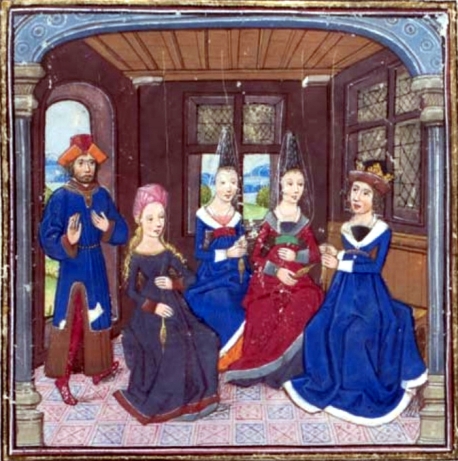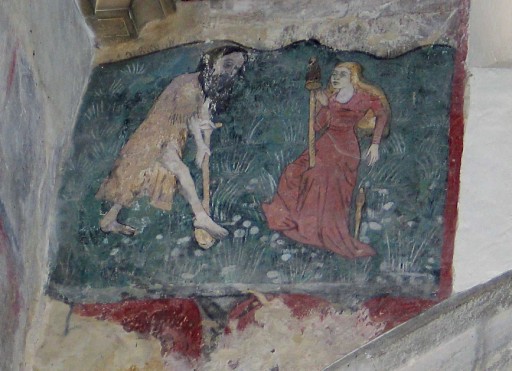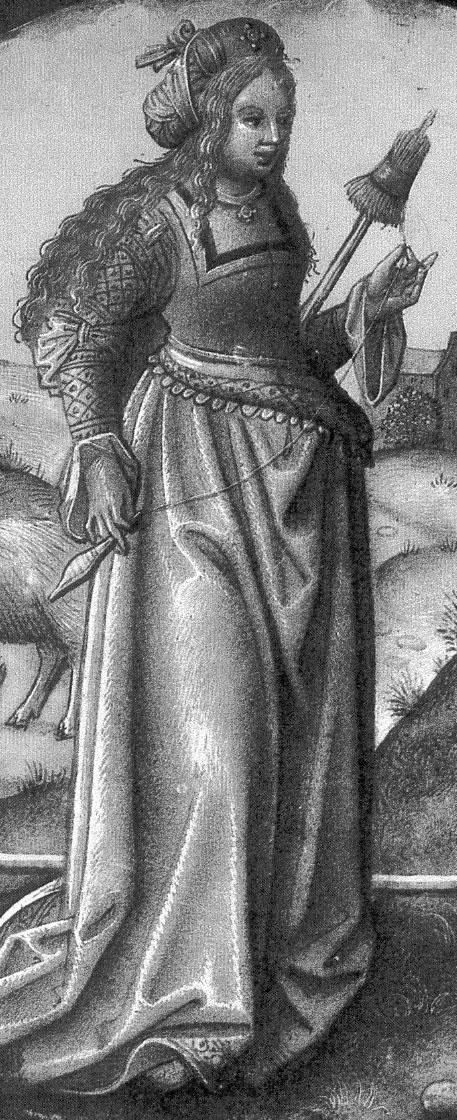Introduction
To say that spinning, the twisting of fibers into a strand, is an art with a long history is like saying there are a couple sheep in New Zealand. Fibers like wool, linen, hemp, jute, nettle, and silk have been used for thousands of years to make yarn, thread, cord, and rope that could be used to make clothing, nets, ship's sails, and even housing. Until the Industrial Revolution normalized machine-spun threads just under two centuries ago, these fibers were spun by hand.
This class will discuss two methods of spinning: European distaff spinning and drop spinning.
Terminology
Spindle: In spindle spinning, the spindle is the item used to twist the fibers into yarn. It also serves as a way to store the spun yarn.
Whorl: The round weight often attached to the spindle as a kind of "fly wheel." It helps keep the spindle spinning when it is suspended.
Shaft: The narrow part of the spindle. The shaft is used for holding the spun yarn and also as a handle. It is the most important part of the spindle, and can be used as a spindle on its own if the whorl is removable.
Roving: The most common way that fiber is prepared for spinning. Roving is formed by carding wool and then drawing it out into a thick rope.
Fleece: "Fleece" most commonly refers to raw wool. "A fleece" refers to the entirety of the wool shorn from a sheep. "A fleece" may have been sorted, or "skirted," but it refers to the whole instead of a portion.
Carding: Carding is the process of brushing wool. It separates the fibers, can remove some tangles, and makes the fiber easier to spin. Carding is relatively new in the history of spinning.
Combing: Combing is the process of using woolcombs to separate fibers. It can be used to remove tangles, short fibers, and foreign matter from wool and other fibers. I have found references to archaeological evidence that shows that wool combing is at least as old as the Viking Age, but it is probably much older.
Ply: Plying involves twisting two or more spun threads together to form a compound strand. It is usually much quicker than spinning single threads.
Drop Spinning
Aside from wheel spinning, drop spinning is the most common form of handspinning in modernized countries like the United States and most spinners today learned how to spin on a drop spindle.Drop spinning consists of winding yarn around the shaft of the spindle, then securing the yarn at the top. The spindle is suspended from the yarn and given a spin, as if it were a spinning top. The fiber is drafted as the spindle spins and the spindle gets closer to the floor as the spinner drafts more fiber.
In this style of spinning, the ease of spinning and the quality of the yarn can be highly dependent on the weight, shape, and quality of the spindle because the speed and momentum of the spindle affects the speed and duration of the spin, while the weight of the spindle affects how thin the yarn can become before it breaks under the strain.
European Distaff Spinning
Spinning yarn using a distaff was so predominant in Medieval Europe that so far I have found it impossible to find a definitive medieval image of anyone spinning wool without a distaff. There are some examples that show women spinning without distaffs, but there is no unspun fiber visible, which has left some to conclude that they are plying yarn, not spinning fiber into single strands.

When spinning with a distaff, the unspun fiber is held on a stick (the distaff) that serves almost as a third hand, leaving one hand free to draft the fiber and the other to spin the spindle. The spindle can be rolled between the fingers or dropped, with a half-hitch knot holding the yarn in place. Because the spindle is supported, the shape of the whorl and the weight of the spindle are much less important than they are in drop spinning. Also, the distaff allows for much finer control of the fiber which can allow a spinner to spin fine yarn with relative ease.


Sources
International Wool Textile Organization. History of Wool. <http://www.iwto.org/wool/history-of-wool/>.
Elizabeth's Fiber and Yarn Store. Introduction to the Spindle. <http://www.fiber2yarn.com/info/spindle.htm>.
http://upload.wikimedia.org/wikipedia/commons/7/76/Hunterian_Psalter_c._1170_Eve_spinning.jpg
https://15thcenturyspinning.files.wordpress.com/2013/06/15th-c-broughton-church-cambridgeshire.jpg
https://15thcenturyspinning.files.wordpress.com/2013/06/pinterest-com.jpg
Further Reading
The Joy of Handspinning. How to Use a Drop Spindle. <http://joyofhandspinning.com/spinning-yarn-with-a-drop-spindle/>.
Cathelina di Allesandri. 15thCenturySpinning (Blog). <https://15thcenturyspinning.wordpress.com/>.
Else Ostergaard. Woven Into the Earth: Textiles from Norse Greenland. Aarhus University Press. 2004.
Abby Franquemont. Respect the Spindle. Interweave Press. 2009.
Alex McConnell. The Early Irish Chronicler (Blog). 2015. <http://www.irishchronicler.blogspot.com/>.

No comments:
Post a Comment